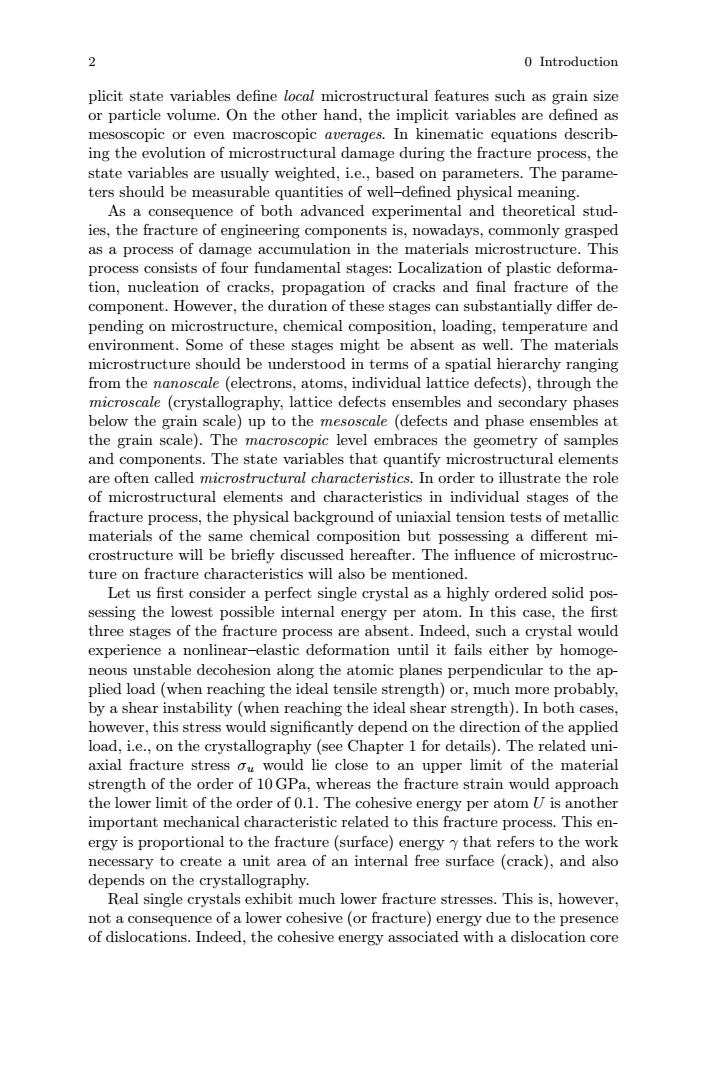正在加载图片...

0 Introduction plicit state variables define local microstructural features such as grain size or particle volume.On the other hand,the implicit variables are defined as mesoscopic or even macroscopic averages.In kinematic equations describ- ing the evolution of microstructural damage during the fracture process,the state variables are usually weighted,i.e.,based on parameters.The parame- ters should be measurable quantities of well-defined physical meaning. As a consequence of both advanced experimental and theoretical stud- ies,the fracture of engineering components is,nowadays,commonly grasped as a process of damage accumulation in the materials microstructure.This process consists of four fundamental stages:Localization of plastic deforma- tion,nucleation of cracks,propagation of cracks and final fracture of the component.However,the duration of these stages can substantially differ de- pending on microstructure,chemical composition,loading,temperature and environment.Some of these stages might be absent as well.The materials microstructure should be understood in terms of a spatial hierarchy ranging from the nanoscale (electrons,atoms,individual lattice defects),through the microscale (crystallography,lattice defects ensembles and secondary phases below the grain scale)up to the mesoscale (defects and phase ensembles at the grain scale).The macroscopic level embraces the geometry of samples and components.The state variables that quantify microstructural elements are often called microstructural characteristics.In order to illustrate the role of microstructural elements and characteristics in individual stages of the fracture process,the physical background of uniaxial tension tests of metallic materials of the same chemical composition but possessing a different mi- crostructure will be briefly discussed hereafter.The influence of microstruc- ture on fracture characteristics will also be mentioned. Let us first consider a perfect single crystal as a highly ordered solid pos- sessing the lowest possible internal energy per atom.In this case,the first three stages of the fracture process are absent.Indeed,such a crystal would experience a nonlinear-elastic deformation until it fails either by homoge- neous unstable decohesion along the atomic planes perpendicular to the ap- plied load(when reaching the ideal tensile strength)or,much more probably, by a shear instability(when reaching the ideal shear strength).In both cases, however,this stress would significantly depend on the direction of the applied load,i.e.,on the crystallography (see Chapter 1 for details).The related uni- axial fracture stress ou would lie close to an upper limit of the material strength of the order of 10 GPa,whereas the fracture strain would approach the lower limit of the order of 0.1.The cohesive energy per atom U is another important mechanical characteristic related to this fracture process.This en- ergy is proportional to the fracture (surface)energy y that refers to the work necessary to create a unit area of an internal free surface (crack),and also depends on the crystallography. Real single crystals exhibit much lower fracture stresses.This is,however, not a consequence of a lower cohesive (or fracture)energy due to the presence of dislocations.Indeed,the cohesive energy associated with a dislocation core2 0 Introduction plicit state variables define local microstructural features such as grain size or particle volume. On the other hand, the implicit variables are defined as mesoscopic or even macroscopic averages. In kinematic equations describing the evolution of microstructural damage during the fracture process, the state variables are usually weighted, i.e., based on parameters. The parameters should be measurable quantities of well–defined physical meaning. As a consequence of both advanced experimental and theoretical studies, the fracture of engineering components is, nowadays, commonly grasped as a process of damage accumulation in the materials microstructure. This process consists of four fundamental stages: Localization of plastic deformation, nucleation of cracks, propagation of cracks and final fracture of the component. However, the duration of these stages can substantially differ depending on microstructure, chemical composition, loading, temperature and environment. Some of these stages might be absent as well. The materials microstructure should be understood in terms of a spatial hierarchy ranging from the nanoscale (electrons, atoms, individual lattice defects), through the microscale (crystallography, lattice defects ensembles and secondary phases below the grain scale) up to the mesoscale (defects and phase ensembles at the grain scale). The macroscopic level embraces the geometry of samples and components. The state variables that quantify microstructural elements are often called microstructural characteristics. In order to illustrate the role of microstructural elements and characteristics in individual stages of the fracture process, the physical background of uniaxial tension tests of metallic materials of the same chemical composition but possessing a different microstructure will be briefly discussed hereafter. The influence of microstructure on fracture characteristics will also be mentioned. Let us first consider a perfect single crystal as a highly ordered solid possessing the lowest possible internal energy per atom. In this case, the first three stages of the fracture process are absent. Indeed, such a crystal would experience a nonlinear–elastic deformation until it fails either by homogeneous unstable decohesion along the atomic planes perpendicular to the applied load (when reaching the ideal tensile strength) or, much more probably, by a shear instability (when reaching the ideal shear strength). In both cases, however, this stress would significantly depend on the direction of the applied load, i.e., on the crystallography (see Chapter 1 for details). The related uniaxial fracture stress σu would lie close to an upper limit of the material strength of the order of 10 GPa, whereas the fracture strain would approach the lower limit of the order of 0.1. The cohesive energy per atom U is another important mechanical characteristic related to this fracture process. This energy is proportional to the fracture (surface) energy γ that refers to the work necessary to create a unit area of an internal free surface (crack), and also depends on the crystallography. Real single crystals exhibit much lower fracture stresses. This is, however, not a consequence of a lower cohesive (or fracture) energy due to the presence of dislocations. Indeed, the cohesive energy associated with a dislocation core